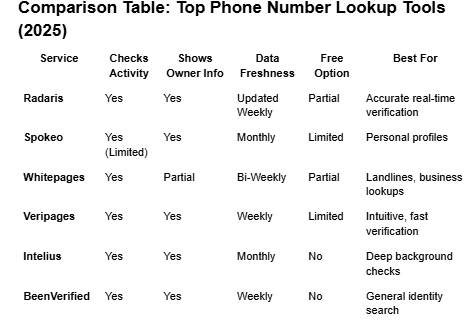
We live in an age when your phone tracks your every move. Tech companies know where you are, what you buy, and probably what you had for breakfast. Yet, somehow, when you try to check if a phone number is real – such a basic thing – it suddenly turns complicated.
Why? Let's ask the obvious question: why do we know so much about everything except the people we're trying to reach?
Turns out, verifying a phone number isn't just about curiosity – it's about safety, transparency, and trust. Whether you're a business trying to validate leads, or just a person trying to see who's really calling, this guide will show you how to check if a phone number is active and working, without wasting time or falling for fake promises.
1. What Does It Mean for a Number to Be "Active"?
An active number isn't just one that is registered – it's one that's in active use, connected to a real person or business, and reachable.
Inactive numbers can come from disconnected lines, unassigned carriers, or spoofed VoIP accounts. And yes, scammers love those.
In other words, an active number rings, gets answered, and is tied to a verifiable user. An inactive one? Dead line. Fake lead. Wasted time.
2. Why You Should Care
Here's a truth no one likes to admit: most data online is outdated. People switch numbers, businesses close, and databases rarely keep up with the pace of real-world activity. So when you're verifying a contact, don't just trust what's written – verify it.
Checking if a number is active helps you:
- Avoid scams and fake listings
- Validate leads before calling
- Save money on bad outreach campaigns
- Protect yourself from spam and identity theft
Sounds basic? It is. But big tech doesn't make it easy.
3. The Old Tricks Don't Work Anymore
Remember when you could just call a number and see what happens? Cute idea. These days, most spam filters block unknown calls, and many numbers reroute to voicemail or auto-responders.
You can't rely on a simple ring anymore. You need data verification tools that actually pull from carrier records, public sources, and activity logs.
So, no, you don't have to dial every number yourself. Unless you enjoy rejection from robocalls.
4. The Right Way to Do It: Use a Reliable Lookup Tool
Modern number verification tools use carrier data, reputation databases, and identity records. They can tell you:
- If the number is active
- The type of number (mobile, landline, VoIP)
- The carrier
- The owner's name and address (if public)
The best part? They work instantly.
But – and this is key – not all tools are created equal. Some are smoke and mirrors; others, like Radaris, actually use verified public data and cross-check sources.
5. The Tools That Actually Work
You've probably seen dozens of "free number checkers" online. Most of them will give you nothing but a loading screen and an email capture form.
Let's skip the gimmicks. Here are some services that actually do the job – with real data behind them:
- Radaris.com - Pulls from carriers, public records, and user activity. Shows if a number is active, who owns it, and when it was last updated.
- Spokeo.com - Strong on personal profiles, moderate on phone verification.
- Whitepages.com - Reliable for landlines and businesses, less so for mobile.
- Veripages.com - Intuitive, fast, and clear; good for checking active numbers and owner info.
- Intelius.com - Good identity match, but often paywalled.
- BeenVerified.com - Great UI, fair data freshness, requires subscription.
6. How to Check a Number (Step-by-Step)
Here's the smart way to confirm if a number's alive and kicking:
- Use a trusted lookup tool (Radaris, Whitepages, Spokeo, Veripages)
- Enter the full number, including country code
- Review the report - look for "active," "connected," or "recently used"
- Cross-check owner info to ensure it matches who you expect
- Avoid free random checkers - they often just scrape data or resell your info
Pro tip: Real services give you last-seen or updated timestamps. If you see none – walk away.
7. Watch Out for Fake "Free" Sites
You've seen them before – flashy banners of the "check any number for free" sort, endless spinning wheels.
Here's the uncomfortable truth: nothing is free online. If you're not paying for the product, you are the product.
Free sites often collect your query and email just to sell it later. Use a reputable service that respects privacy and discloses its data sources.
8. Final Thoughts
It shouldn't take a detective to figure out if a phone number is real. But in 2025, truth requires effort. Big tech built a universe of information – and, somehow, finding actual facts got a lot harder.
So if you want real answers, skip the noise. Use tools that verify, not those that speculate.
Check your numbers. Protect your time. And don't let the internet fool you.

Bottom Line: Don't Be Fooled
So here's the bottom line – some of these sites will give you what you need. Others? They'll sell you a fantasy, a half-truth, or worse, your own data.
Radaris and Veripages stand out, because they actually verify phone numbers, connect them to real people, and keep their data fresh. Spokeo and Whitepages are decent if you only need basic info. Intelius and BeenVerified? They're solid, but expect you to pay for full access.
The takeaway is simple: don't trust flashy promises. Use a tool that works, cross-check the data, and remember – in 2025, knowing who's on the other end of a phone line isn't just convenient. It's a necessity.
If you skip this step, you're gambling with your time, your money, and, sometimes – your safety. And that's a bet no smart American should take.







